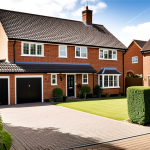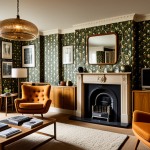Understanding the Importance of Lighting in UK Homes
Lighting is a vital aspect in defining the aesthetic appeal of homes across the United Kingdom. The way a room is lit not only enhances its visual appeal but also transforms the ambiance, creating spaces that are not just functional but also mood-enhancing.
Effective residential lighting plays a significant role in functionality by providing the necessary illumination for different tasks while also setting the desired tone. Whether you’re prepping a meal in the bright lights of a kitchen or unwinding in a softly lit living room, the choice of lighting significantly impacts your daily experiences.
This might interest you : What are the best ways to incorporate vintage style into UK interiors?
A modern focus in UK home lighting is on energy efficiency. With growing environmental concerns, choosing energy-efficient lighting has become crucial. This choice not only contributes to lowering carbon footprints but also offers long-term cost savings by reducing energy bills. Opting for LED bulbs or energy-saving fittings, for instance, supports a sustainable lifestyle, aligning with the eco-conscious values predominant in today’s UK households.
In summary, lighting’s significance extends beyond mere illumination. Its role in enhancing aesthetics, improving functionality, and promoting energy efficiency underscores its essential place in UK homes.
Also to see : How Can Technology Transform Our Living Spaces at Home?
Types of Lighting Solutions
Understanding the different types of lighting solutions can vastly improve the usability and appearance of your UK home. Each type serves its unique purpose, from creating general lighting to highlighting specific features.
Ambient Lighting
Ambient lighting is the foundational layer of light in a room. This type of lighting provides uniform illumination, ensuring the space is adequately lit. It’s the base living environment lighting that allows you to navigate a room comfortably. Ceiling fixtures, such as chandeliers or recessed lights, are common choices for achieving effective ambient lighting.
Task Lighting
Task lighting is designed to assist with specific activities. Whether it’s cooking, reading, or working, this focused lighting ensures you have the right illumination for detailed tasks. Under-cabinet lights in kitchens or a desk lamp in a study are excellent examples. The primary goal is to enhance precision and reduce eye strain, making activities more comfortable and efficient.
Accent Lighting
Accent lighting adds drama to a room by creating visual interest. It highlights particular objects or architectural features, drawing the eye to paintings, sculptures, or textured walls. Often, a spotlight or track lighting is used to achieve this effect. Successful accent lighting creates a focal point, adding depth and dimension to your living spaces.
Considering Room Size and Purpose
Choosing the right lighting for a space involves careful consideration of room size and purpose to ensure each area is optimally lit. The dimensions of a room significantly influence the type and number of lighting fixtures needed. For instance, large, open-plan living areas may require a blend of ambient, task, and accent lighting to create a balanced and inviting environment, while smaller rooms might benefit from fewer fixtures strategically placed to avoid overcrowding.
Tailoring lighting solutions to different areas of a home maximizes both functionality and aesthetic appeal. In kitchens, bright task lighting is essential for cooking, preferably positioned above countertops or workspaces. Meanwhile, a living room may demand a mix of ambient lighting and accent pieces to highlight artworks or architectural features. Bedrooms benefit from softer, adjustable lighting that facilitates relaxation, along with task lighting for reading or working.
When selecting lighting, it is also crucial to comply with UK safety and design regulations. These standards ensure that lighting installations are safe and efficient, minimizing risks such as electrical faults or inefficient energy use. Following these guidelines not only optimizes lighting for specific spaces but also ensures safety and compliance within UK homes.
Light Bulb Types and Their Uses
Selecting the correct light bulb type is crucial for maximizing both the visual appeal and functionality of a space. In UK homes, the variety of bulb types available can cater to diverse lighting needs and preferences. Understanding the differences between incandescent, LED, and fluorescent bulbs, and their respective applications in different rooms, is key to making informed decisions.
Incandescent Bulbs
Incandescent bulbs are the traditional choice, known for their warm, inviting light. Although often less energy-efficient compared to newer options, these bulbs are ideal for spaces where ambiance is prioritized over energy savings. Their soft glow makes them a popular choice for creating a cozy atmosphere in living rooms and bedrooms.
LED Bulbs
LED bulbs are at the forefront when considering energy-efficient lighting. These bulbs are known for their cost-effectiveness and longevity, significantly reducing energy consumption while offering a variety of lighting tones. LEDs are versatile, suitable for almost any room, and particularly excel in task-oriented spaces like kitchens and studies due to their brightness and clarity.
Fluorescent Bulbs
Fluorescent bulbs provide a bright, white light suitable for areas requiring high visibility, such as workshops or garages. These bulbs are more energy-efficient than incandescents, making them a solid choice for frequent use in utility spaces. However, their light tends to be harsher, which might not suit every environment.
In choosing UK lighting products, consider the specific needs of each room. For instance, while an LED bulb might be best suited for kitchen task lighting, an incandescent bulb could enhance the comfort of a living area. Familiarize yourself with popular bulb brands in the UK, as many offer bulbs tailored to these diverse requirements.
Latest Trends in Home Lighting for UK Interiors
In the realm of UK interior design, lighting has transcended its basic purpose to become a crucial element of style and innovation. Today’s current lighting trends focus heavily on integrating classic styles with modern advancements, particularly in the use of smart technology. This fusion not only enhances functionality but also elevates the visual appeal of any home.
Smart lighting technology is a standout trend, allowing homeowners unprecedented control over their lighting environments. Through smartphone apps or voice-activated systems, one can easily modify light intensity, color temperatures, and even synchronize lights with daily routines. This adaptability caters to the increasingly busy lifestyles in the UK, optimizing for either relaxation or productivity as needed.
On the style front, popular styles include minimalist fixtures and sculptural designs, which resonate with the sleek, modern decor found in many UK homes. These designs often embrace materials like brass, copper, and glass, adding elegance and a touch of luxury. Retro and industrial themes have also made a comeback, with fixtures that feature exposed bulbs and metallic finishes.
Examples of trending fixtures include pendant lights and LED strips, commonly used in kitchens and lounges to create clean lines and vibrant spaces. These styles provide both functional and aesthetic versatility, making them a preferred choice among UK homeowners looking to add a contemporary flair to their interiors. These designs offer a brilliant mix of tradition and technology, reflecting both personal taste and the general move towards energy-efficient solutions.
Energy-Efficient Lighting Options
In the evolving landscape of UK home lighting, energy-efficient lighting options are becoming increasingly crucial for environmentally conscious homeowners. The shift towards eco-friendly options not only supports sustainable living but also offers substantial savings on electricity bills, aligning with stringent UK energy standards. This section explores the benefits of various lighting solutions and provides guidance on making greener choices.
LED vs. Traditional Bulbs
When comparing LED bulbs to traditional bulbs like incandescents, LEDs stand out for their energy-saving capabilities and long lifespan. LEDs consume significantly less electricity, reducing energy usage and costs over time. Traditional bulbs, although commonly used for their warmth, fall short in efficiency and durability. LEDs also offer versatility in light colour and brightness, making them suitable for various lighting needs throughout the home.
Smart Lighting Solutions
Integrating smart lighting technologies into UK homes has revolutionized the way households manage their lighting systems. Smart lighting allows users to control their home lighting remotely or through voice commands, optimizing light usage and enhancing convenience. Systems like app-controlled bulbs can adjust brightness and schedule operations, providing personalised lighting that complements lifestyle needs. Smart lighting is an integral part of eco-friendly home designs, offering both modern style and functional benefits.
Benefits of Energy Star Rated Products
Opting for Energy Star-rated products is a reliable method for ensuring energy-efficiency in your home. These products meet strict criteria set by the UK on performance, resulting in lower energy bills and environmental impact. Energy Star-rated lights and fixtures are designed to use less energy while maintaining quality and performance, offering a prudent choice for eco-conscious homeowners. Prioritizing such products ensures adherence to high sustainability standards without compromising on style or functionality.
By understanding the advantages and applications of energy-efficient lighting, homeowners can make informed decisions that benefit both their wallets and the environment.






